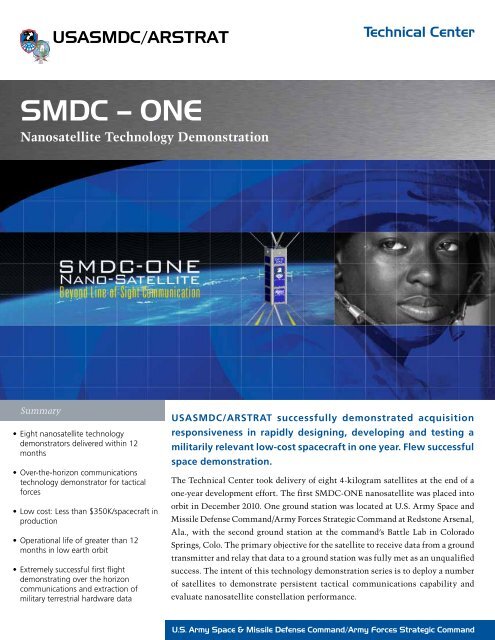SMDC – ONE - Space and Missile Defense Command - U.S. Army
SMDC – ONE - Space and Missile Defense Command - U.S. Army
SMDC – ONE - Space and Missile Defense Command - U.S. Army
Create successful ePaper yourself
Turn your PDF publications into a flip-book with our unique Google optimized e-Paper software.
USA<strong>SMDC</strong>/ARSTRAT<br />
Technical Center<br />
<strong>SMDC</strong> <strong>–</strong> <strong>ONE</strong><br />
Nanosatellite Technology Demonstration<br />
Summary<br />
• Eight nanosatellite technology<br />
demonstrators delivered within 12<br />
months<br />
• Over-the-horizon communications<br />
technology demonstrator for tactical<br />
forces<br />
• Low cost: Less than $350K/spacecraft in<br />
production<br />
• Operational life of greater than 12<br />
months in low earth orbit<br />
• Extremely successful first flight<br />
demonstrating over the horizon<br />
communications <strong>and</strong> extraction of<br />
military terrestrial hardware data<br />
USA<strong>SMDC</strong>/ARSTRAT successfully demonstrated acquisition<br />
responsiveness in rapidly designing, developing <strong>and</strong> testing a<br />
militarily relevant low-cost spacecraft in one year. Flew successful<br />
space demonstration.<br />
The Technical Center took delivery of eight 4-kilogram satellites at the end of a<br />
one-year development effort. The first <strong>SMDC</strong>-<strong>ONE</strong> nanosatellite was placed into<br />
orbit in December 2010. One ground station was located at U.S. <strong>Army</strong> <strong>Space</strong> <strong>and</strong><br />
<strong>Missile</strong> <strong>Defense</strong> Comm<strong>and</strong>/<strong>Army</strong> Forces Strategic Comm<strong>and</strong> at Redstone Arsenal,<br />
Ala., with the second ground station at the comm<strong>and</strong>’s Battle Lab in Colorado<br />
Springs, Colo. The primary objective for the satellite to receive data from a ground<br />
transmitter <strong>and</strong> relay that data to a ground station was fully met as an unqualified<br />
success. The intent of this technology demonstration series is to deploy a number<br />
of satellites to demonstrate persistent tactical communications capability <strong>and</strong><br />
evaluate nanosatellite constellation performance.<br />
U.S. <strong>Army</strong> <strong>Space</strong> & <strong>Missile</strong> <strong>Defense</strong> Comm<strong>and</strong>/<strong>Army</strong> Forces Strategic Comm<strong>and</strong>
<strong>SMDC</strong> <strong>–</strong> <strong>ONE</strong><br />
Nanosatellite Technology Demonstration<br />
Technical Center<br />
To achieve enhanced capabilities from space for the<br />
dismounted Warfighter, an approach holding great<br />
promise is the deployment of nanosatellite-class satellite<br />
constellations into low earth orbit. Because the unit cost<br />
for a nanosatellite (nanosat) is low (less than $1 million),<br />
large numbers for given specific missions can be built <strong>and</strong><br />
deployed on orbit to generate a persistent effect. What a<br />
nanosat may lack in performance <strong>and</strong> long-life reliability<br />
compared to a single large traditional military satellite,<br />
it makes up by its extremely low cost <strong>and</strong> constellation<br />
proliferation potential.<br />
Nanosats deployed in large numbers can provide<br />
enhanced capabilities over specific regions, over large<br />
latitudinal swaths of the earth, or even globally. Because<br />
they are low cost, they can be “refreshed” frequently by<br />
launching replacements. This allows rapid technology<br />
upgrades, reduces unit design life requirements, <strong>and</strong> allows<br />
manufacturing economies of scale. A nanosat constellation<br />
populated by inexpensive spacecraft could be useful in a<br />
myriad of applications including tactical ground operations,<br />
humanitarian support, <strong>and</strong> stability operations.<br />
The first <strong>SMDC</strong>-<strong>ONE</strong> nanosatellite was launched Dec.<br />
8, 2010, into a slightly elliptical orbit about 185 miles<br />
above the earth. Ground stations in Huntsville, Ala., <strong>and</strong><br />
in Colorado Springs, Colo. sent messages back <strong>and</strong> forth via<br />
the satellite, demonstrating beyond-line-of-sight <strong>and</strong> overthe-horizon<br />
communications between the ground stations<br />
located more than 1,000 miles apart.<br />
Each ground station operated in one of two modes: (1) as a<br />
comm<strong>and</strong> <strong>and</strong> control center; or (2) as a data file transmitter/<br />
receiver site for mission data. Various text <strong>and</strong> image<br />
files were sent in the mission data mode while spacecraft<br />
comm<strong>and</strong>s were issued to the satellite in the comm<strong>and</strong> <strong>and</strong><br />
control center mode.<br />
that data down to a separate, very simple ground station<br />
consisting of a simple antenna, small gateway (radio) <strong>and</strong><br />
laptop computer with software to display the information on<br />
a Google Earth map. Due to the very low orbit altitude, the<br />
satellite re-entered the earth’s atmosphere <strong>and</strong> disintegrated<br />
35 days after launch, having performed exceptionally well<br />
throughout its five weeks in space.<br />
This relatively brief space technology demonstration<br />
indicated great potential for these very small satellites with<br />
masses of only a few kilograms each. <strong>SMDC</strong>-<strong>ONE</strong> responded<br />
well to various comm<strong>and</strong>s. <strong>Army</strong> personnel learned a great<br />
deal about satellite tracking <strong>and</strong> communications in their<br />
operation of the two <strong>SMDC</strong>-<strong>ONE</strong> ground stations.<br />
The satellite proved to be consistent <strong>and</strong> reliable during<br />
its predictable revolutions around the earth. Ground<br />
station anomalies were quickly identified <strong>and</strong> corrected<br />
as the ground stations experienced very cold, snowy <strong>and</strong><br />
icy conditions at times. Undocumented features of the<br />
satellite were quickly addressed <strong>and</strong> accommodated. The<br />
mission exhibited flexibility by incorporating a separate,<br />
very small ground station with data collection <strong>and</strong> display<br />
from ground military hardware. At the time of launch, given<br />
the predicted short orbital life, such a demonstration was<br />
considered unlikely.<br />
In summary, the <strong>Army</strong>’s first satellite in 50 years proved<br />
to be a resounding success <strong>and</strong> a great encouragement to<br />
press forward in helping to secure the high ground with the<br />
assistance of nanosatellites.<br />
State-of-health data from the satellite were collected<br />
on the first orbital revolution <strong>and</strong> good communications<br />
with the satellite continued throughout the demonstration<br />
mission. After about three weeks in orbit, the satellite<br />
collected data from military ground hardware <strong>and</strong> sent<br />
www.army.mil/smdc<br />
For more information, please contact:<br />
USA<strong>SMDC</strong>/ARSTRAT Public Affairs Office<br />
P.O. Box 1500<br />
Huntsville, AL 35807<br />
Phone: 256-955-3887<br />
Fax: 256-955-1214<br />
Email: webmaster@smdc.army.mil<br />
www.facebook.com/armysmdc<br />
www.twitter.com/armysmdc<br />
www.flickr.com/armysmdc<br />
www.youtube.com/armysmdc<br />
Distribution A 0112/0111

















